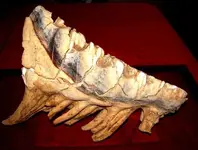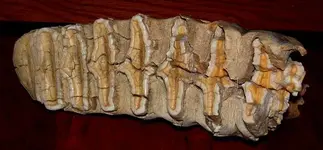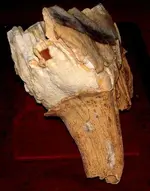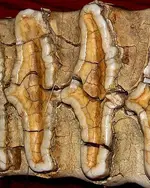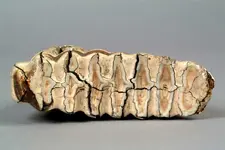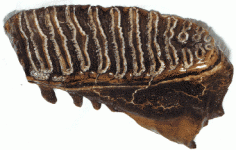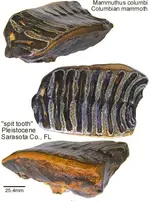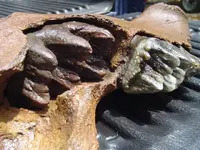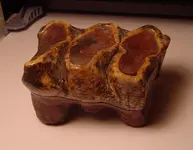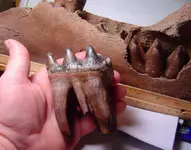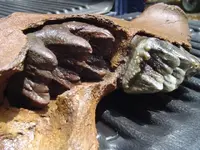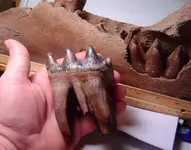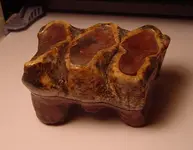This is from my earlier thread, "CONSOLIDATING TEETH AND BONES."
Posted Jun 18, 2009, 03:32:02 PM
Here a technique for consolidating (impregnating with plastic) mammal teeth and bones with some easily-purchased materials.
N.B. There are other sorts of teeth and bone which may benefit from such preservation, but it's usually not necessary nor is it desireable to consolidate shark teeth.
What not to do: Don't use varnish or polyurethane. Polyurethane will not give the desired penetration of the fossil. Putting polyurethane on a fossil is usually a bad idea.
I recommend against white glue (polyvinyl acetate) as a consolidant because there are better materials available. Rarely, a specimen cannot be dried without it crumbling, and white glue is the only reasonable answer. In my experience, white glue is messy and never looks good when the specimen is fully-prepared. (Normal prep lab dilution of white glue is one part water to two parts glue.)
A much better material for bone is a polyvinyl butyral plastic such as Butvar-76, but that material is hard to find in small quantities. I have used this plastic, dissolved in acetone, for many types of fossils. (I have used it successfully on Silurian-age shales with brachiopods, for example.) It penetrates well, and in the proper dilution it produces a "damp-looking" finish with no gloss.
Butvar-76 (but not other Butvar varieties) is also soluble in alcohol. (I assume that is denatured alcohol that you can buy in gallon cans.) I have never tried this solution for consolidation. The alcohol would take considerably longer to boil off the treated specimen.
So, what works that is available? I recommend a solution of Duco Cement (colorless, like model airplane glue) in acetone.
Dilution? Start with a tube of glue dissolved in about eight ounces of acetone in a glass jar. Shake well.
Adjust the solution with more acetone until, after shaking, the tiniest air bubbles are just slightly retarded in their rise to the surface.
I usually heat specimens with an infra-red lamp to drive off moisture just before dipping the fossil. I do this with all sorts of fossils, and have never had one damaged by the heating. The untreated specimen is always at least as wet at the relative humidity of the air around it, I suppose. (A microwave oven may be as effective, but I've only dried glass beads for my air-abrasive unit.)
Do NOT heat the acetone solution directly. The acetone solution will get warm after dipping a number of heated fossils. You must have good ventilation to deal with the fumes!
I use a long-jawed forceps -- ten-inch tweezers, really -- to dip and/or retreive the fossils from the jar.
Ideally, you would submerge the dry specimen in this consolidant for a brief time (say 15-30 seconds, or until the specimen stops fizzing). Set each wet specimen aside to dry on cardboard (I use beer-flats).
For a specimen too thick to be submerged, you can use a turkey-baster to flood the difficult areas. I treated an adult mammoth tibia that, because of its size, I dried in the Florida sun, then used the baster to pump consolidant into every opening of the bone.
I use the glass jar to submerge smaller fossils -- whatever will fit through the mouth of the jar. For larger fossils, I use a RubberMaid-type cake-pan to hold the consolidant for this soaking step - that plastic seems to be impervious to the acetone. Get 'em at your local dollar-store.
Acetone evaporates very quickly. Replenish the consolidant mixture with a bit of acetone if you are using it on many specimens. Store it in a tightly sealed glass jar. Even if some acetone evaporates away between uses (it always does, it seems), you can reconstitute the solution by replacing the acetone.
Acetone is a nasty solvent. The fumes are explosive. The fumes are toxic. The liquid penetrates the skin-blood barrier. It's best to use gloves. Use in a well-ventilated area.
--------------Harry Pristis



